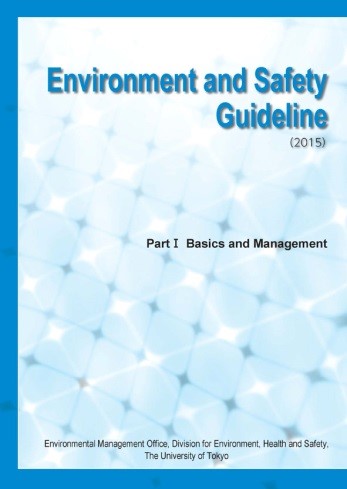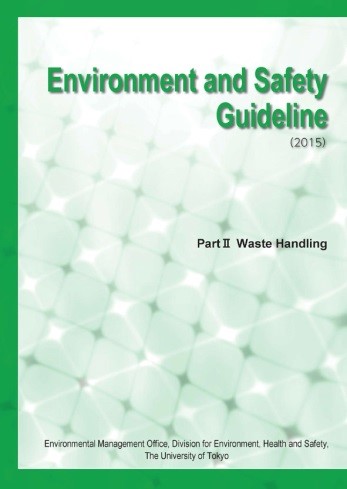Environment and Safety Guideline
Environment and Safety Guideline (2015)
We have revised the 9th edition of Environment and Safety Guideline (2005) and here we publish the 10th edition. In this revision, we have made a complete renewal of the contents to issue the Guideline in two separate volumes.
In the 9th and earlier editions, emphasis was put on the management of laboratory safety and the control of wastes and drainage. Since the transformation of the University of Tokyo into the national university corporation in April 2004 the management system of environment and safety in the University of Tokyo has been developed and expanded, and currently the system is in an almost stable condition. In the meantime, the sense of the “management of environment and safety” has changed from a narrow meaning of “not to cause environmental pollutions due to one’s conduct” to a broader meaning that also includes “safety of both oneself and other people (outside the organization) through continuous improvement of the workplace environment.” In this 10th edition, as the first step of establishing the guideline of environment and safety management in the aforementioned broader sense, we summarized the overview of the management of environment and safety in Part I and the information concerning waste management in Part II.
Part I “Basics and Management” describes fundamental information on the management of environment and safety in the University of Tokyo. Chapters 1, 2, 4, and 5 should be read and understood by all the members of the University of Tokyo regardless of whether one is engaged in experimental work or not. Chapter 3 needs to be read through and referred to by those who are more or less in the managerial position in an educational, research, administrative, or technical group. Those who are engaged in experimental work and who are in charge of their management should read and understand Chapters 6 and 7 irrespective of type of their experiment, and in addition, they should fully understand the contents of corresponding parts in Chapters 8 to 11 depending on the material and subject of their experiment.
Part II “Waste Handling” explains the handing of wastes in detail, which is the most basic matter for the environmental conservation. The contents of Chapters 1 to 3 need to be understood by the entire members of the University of Tokyo. Those who are engaged in experimental work should read Chapter 4 and understand the contents well because this chapter describes the basic handling manner of experimental wastes that can possess various hazards. Additionally, Chapter 5 concretely describes the way to dispose of chemically hazardous wastes that are generated frequently in a large volume. Therefore, those who generate chemically hazardous wastes (mainly the wastes generated in experiments using chemical reagents) must fully understand the contents of this chapter and follow the prescribed rules correctly. Those who conduct experiments using living things (microorganisms, animals, and plants) should understand the contents of Chapter 6 well. Chapter 7 describes the handling of wastes in medical institutions such as the university hospitals. Chapter 8 explains the handling rules of wastes generated in the facilities remote from major campuses and in joint use facilities outside the University of Tokyo.
After the drastic revision of the Guideline into separate volumes, we suppose there still remains much room for improvements. Please send us your comments. We would like to reflect your opinions in subsequent revisions. Finally we hope that this Guideline is fully utilized by the members of the University of Tokyo.
March 2015
Masanori Owari
General Manager of Environmental Management Office,
Division for Environment, Health and Safety,
The University of Tokyo

Part I “Basics and Management” |

Part II “Waste Handling” |
|---|---|
| Chapter 1 Philosophy of Environmental Safety Chapter 2 Management System of Environment, Health and Safety in UTokyo Chapter 3 Regulations Related to Environmental Safety at the University Chapter 4 Approach of UTokyo to the Environmental Conservation Chapter 5 Current State of Safety at UTokyo Chapter 6 Fundamentals of Experimental Safety Chapter 7 Laboratory Safety Chapter 8 Safe Handling of Chemical Substances Chapter 9 Safe Handling of High Pressure Gas Chapter 10 Safe Handling of Radiation and Radioactive Isotopes Chapter 11 Biosafety of Biological Experiments |
Chapter 1 Fundamental Principles for Waste Management at UTokyo Chapter 2 Classification of Wastes at UTokyo Chapter 3 Daily-life Wastes Chapter 4 Handling of Laboratory Wastes Chapter 5 Collection and Disposal of Chemically Hazardous Waste Chapter 6 Handling of Waste Material from Biological Experiments Chapter 7 Handling of Medical Waste Materials at the Hospitals Affiliated with UTokyo Chapter 8 Handling Waste Materials at the Remote Facilities and Shared Use Facilities |
Please contact Environment, Health, and Safety Officers in your graduate school/institute to get guideline books.
For non-UTokyo members, please visit this page.
<環境安全事務担当者の方へ>
以下の事柄をご記載の上、下記問い合わせ先にメールにてお申し込みください。(有償となります)
1. 部局名・担当者名・連絡先(E-mailおよび電話番号)
2. 振替コード
3. 送付先
4. 環境安全指針必要部数
5. 環境安全講習会テキスト必要部数
<問い合わせ先>
環境安全研究センター 「環境安全指針担当」
内線22972 E-mail:shishin★esc.u-tokyo.ac.jp(★を@に置換)